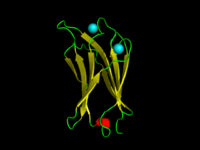
Photo from wikipedia
Ciliopathies are a group of genetically heterogeneous disorders, characterized by defects in cilia genesis or maintenance. Mutations in the RPGR gene and its interacting partners, RPGRIP1 and RPGRIP1L, cause ciliopathies,… Click to show full abstract
Ciliopathies are a group of genetically heterogeneous disorders, characterized by defects in cilia genesis or maintenance. Mutations in the RPGR gene and its interacting partners, RPGRIP1 and RPGRIP1L, cause ciliopathies, but the function of their proteins remains unclear. Here we show that knockdown (KD) of RPGR, RPGRIP1 or RPGRIP1L in hTERT-RPE1 cells results in abnormal actin cytoskeleton organization. The actin cytoskeleton rearrangement is regulated by the small GTPase RhoA via the planar cell polarity (PCP) pathway. RhoA activity was upregulated in the absence of RPGR, RPGRIP1 or RPGRIP1L proteins. In RPGR, RPGRIP1 or RPGRIP1L KD cells, we observed increased levels of DVl2 and DVl3 proteins, the core components of the PCP pathway, due to impaired proteasomal activity. RPGR, RPGRIP1 or RPGRIP1L KD cells treated with thapsigargin (TG), an inhibitor of sarcoendoplasmic reticulum Ca2+- ATPases, showed impaired store-operated Ca2+ entry (SOCE), which is mediated by STIM1 and Orai1 proteins. STIM1 was not localized to the ER-PM junction upon ER store depletion in RPGR, RPGRIP1 or RPGRIP1L KD cells. Our results demonstrate that the RPGR protein complex is required for regulating proteasomal activity and for modulating SOCE, which may contribute to the ciliopathy phenotype.
Journal Title: Oncotarget
Year Published: 2018
Link to full text (if available)
Share on Social Media: Sign Up to like & get
recommendations!